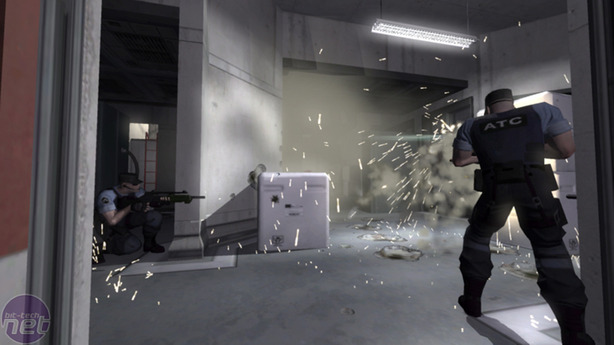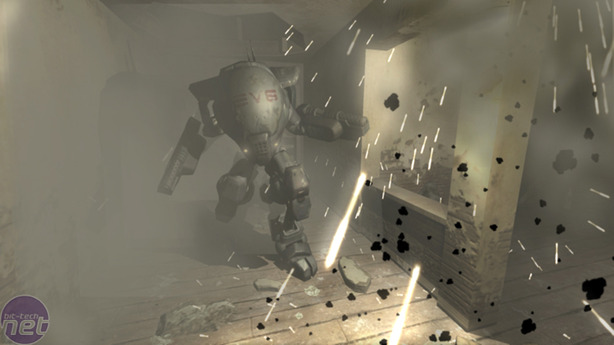
It’s usually a challenge to get excited about a console port of a PC game that’s nearly two years old, but for me F.E.A.R. is a real exception. For one thing, the PlayStation 3 currently suffers from a lack of top-drawer shooters.
Resistance: Fall of Man is a bit of a mediocrity, while Call of Duty 3 – the low-point of the series – is a bit of a mess in its single-player mode. F.E.A.R. however, still stands out as one of the finest PC FPS games of recent years, and made an excellent Xbox 360 conversion just last year. Surely, given the obvious hardware beef of the PS3, it can’t fail to be a winner.
What’s more, it is one of the few titles we can compare across all three ‘next-generation gaming’ platforms. Admittedly, it’s wise to take these comparisons with a pinch of salt – they usually say more about the strengths of the development teams and their experience with the development tools on each platform than the capabilities of the systems involved – but they can be interesting nonetheless. With all that power at its disposal, surely the PS3 can make this F.E.A.R. the scariest action thriller yet?
The game’s major problem was, let’s say, a singularity of tone. F.E.A.R. stuck close to real-life for its level design, going large on industrial and office locations, but while the intention might have been to make the ordinary extraordinary, the effect was that the locations were frequently short on ‘wow’ factor and the setting soon grew dull.
There simply wasn’t enough variation, and certain sections of the game, particularly the lengthy central portion based in the Armacham building, wore on long past their welcome. With only a handful of different enemy types to battle, you could be excused for feeling that F.E.A.R. could only serve up one basic experience, over and over and over again.
What saved the game and elevated it to near-greatness was that this experience was really bloody good. It was the combat itself that made F.E.A.R. so exciting, and it all came down to two factors: the cunning, adaptive enemy AI and a glorious slow-mo feature that rapidly became the signature element of the game.
Faced with overwhelming numbers of hostile troops, capable of moving and firing as a team, your only hope was to kick in your hyper reflexes, stretching time with an awesome combination of blurred visuals and slowed-down sound. Max Payne might have done the ‘bullet time’ trick first, but F.E.A.R. did it better, each battle becoming a spectacle of whirling projectile traces, floating rag-doll bodies, splattered blood and luscious particle effects.
Every fire-fight became a test of your guts and tactical intuition. Leap from here, blast him, turn, headshot, sprint, shoot the guy racing in from left, jump into cover and pause for breath. The fact that the slow-mo power ran on a recharging gauge also made the game full of gut-churning moments of tension and release, with you anxiously watching the bar fill up while you could hear your foes footsteps and radio exchanges drawing nearer to your hiding place. It was totally thrilling, utterly addictive stuff.
Resistance: Fall of Man is a bit of a mediocrity, while Call of Duty 3 – the low-point of the series – is a bit of a mess in its single-player mode. F.E.A.R. however, still stands out as one of the finest PC FPS games of recent years, and made an excellent Xbox 360 conversion just last year. Surely, given the obvious hardware beef of the PS3, it can’t fail to be a winner.
What’s more, it is one of the few titles we can compare across all three ‘next-generation gaming’ platforms. Admittedly, it’s wise to take these comparisons with a pinch of salt – they usually say more about the strengths of the development teams and their experience with the development tools on each platform than the capabilities of the systems involved – but they can be interesting nonetheless. With all that power at its disposal, surely the PS3 can make this F.E.A.R. the scariest action thriller yet?
F.E.A.R. and loathing
OK, so it has to be said that F.E.A.R. was never perfect. Aspects of the graphics engine were superb, the enemy AI was revolutionary and the introduction of elements dragged from Japanese horror games and horror movies – notably the first Silent Hill and The Ring – was inspired. The selection of weapons remains one of the best of modern FPS games. The usual sub-machine guns, shotguns and assault rifles were ideal for mopping up the Replica cannon-fodder, the wonderful Penetrator fired high-velocity spikes that left foes stuck hanging limply from the walls, and the plasma rifle did a wonderful job of transforming hostiles into so much charred skeleton. There were even some great enemies to fight. Who can forget the fiendish cyber-ninjas, or those hard-as-nails armoured troops?The game’s major problem was, let’s say, a singularity of tone. F.E.A.R. stuck close to real-life for its level design, going large on industrial and office locations, but while the intention might have been to make the ordinary extraordinary, the effect was that the locations were frequently short on ‘wow’ factor and the setting soon grew dull.
There simply wasn’t enough variation, and certain sections of the game, particularly the lengthy central portion based in the Armacham building, wore on long past their welcome. With only a handful of different enemy types to battle, you could be excused for feeling that F.E.A.R. could only serve up one basic experience, over and over and over again.
What saved the game and elevated it to near-greatness was that this experience was really bloody good. It was the combat itself that made F.E.A.R. so exciting, and it all came down to two factors: the cunning, adaptive enemy AI and a glorious slow-mo feature that rapidly became the signature element of the game.
Faced with overwhelming numbers of hostile troops, capable of moving and firing as a team, your only hope was to kick in your hyper reflexes, stretching time with an awesome combination of blurred visuals and slowed-down sound. Max Payne might have done the ‘bullet time’ trick first, but F.E.A.R. did it better, each battle becoming a spectacle of whirling projectile traces, floating rag-doll bodies, splattered blood and luscious particle effects.
Every fire-fight became a test of your guts and tactical intuition. Leap from here, blast him, turn, headshot, sprint, shoot the guy racing in from left, jump into cover and pause for breath. The fact that the slow-mo power ran on a recharging gauge also made the game full of gut-churning moments of tension and release, with you anxiously watching the bar fill up while you could hear your foes footsteps and radio exchanges drawing nearer to your hiding place. It was totally thrilling, utterly addictive stuff.

MSI MPG Velox 100R Chassis Review
October 14 2021 | 15:04











Want to comment? Please log in.